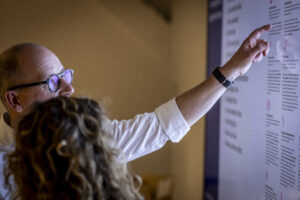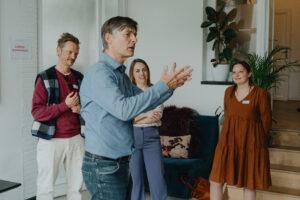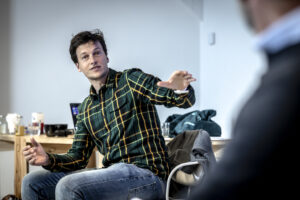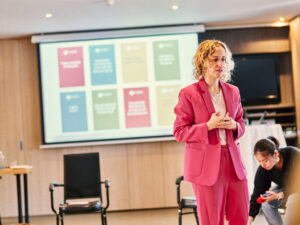At Beanmachine we love to share our knowledge with clients, with each other, and also with the new generation of business leaders. Recently, Geert and I had the privilege to give a masterclass on Organizational Design to students Master of Science in International Management at the Franklin University Switzerland for the second year in a row. Unfortunately, this year we couldn’t combine it with a quick short ski.
In a 3-day course, we took a deep dive into Organization Design & Development. Keeping it interactive with tools such as Mentimeter to ask questions during the course and Mural to go digital with our canvasses.
Day 1: Overall OD Quest and Organization Models
Strategy, structure, culture, and people are powerful forces in any organization and thus form the building blocks for Organizational Development. Aligning them is crucial but also complex.
First, we had a look at the different blocks of organizational development and how they interact with each other. Reflecting on questions such as: does our structure clearly follow our strategy? And do we have the right people capabilities to implement the planned organizational structure?
Day 2: Aligning structure with Organizational Strategy
After a deep dive into the work of organizational theorists like Mintzberg, Galbraith, etc we rolled up our sleeves and gathered around the (virtual) drawing board. Armed with our Beanmachine OD Toolkit students learned how to generate alternative org structures and how to assess their potential.
Students experienced that there is no such thing as the perfect org model and that one needs to go beyond OD hypes.
Day 3: Governance, culture, and organizational responsiveness
Having a nice structure on paper is not enough. To check whether a structure is really sound and solid you need to run water through the pipes. Are roles clearly defined? Is the governance in line with the strategic ambition? And what type of decision making works best in which type of organization?
Following our motto ‘eat your own dogfood’ we used the consent decision-making method to let students decide whether they would grade each other or rely solely on us for their evaluation. They decided to go for peer evaluation. We thought that was a courageous and wise decision.
After
Just like we do in our work with clients, the learning doesn’t stop when we leave the classroom. We sent our students away with a mission. In the weeks after the course they all interviewed CEOs of large companies, assessed the current org structure, and gave advice on how to adapt or even re-design it.
And for us? Geert and I felt energised by being able to share our knowledge and grateful for the feedback we received:
- I really appreciated this course as it helped me to increase my learning in a more interactive way.
- Hans and Geert were phenomenal professors! I wish there were an option to give a higher ranking than “strongly agree”. Despite the courses being online, the atmosphere they created had the entire class fully engaged. I would highly recommend this course to any other student.
- This course was extremely useful for my future in business and management. I wish we had more than three days to fully absorb all of the professors’ information.
- I found this course very inspiring and interesting. Probably 3 days is not enough, would be much better to have at last 1 or 2 weeks in order to elaborate all the contents and have the opportunity to work on more real business case studies.





